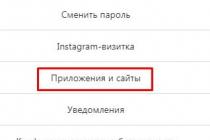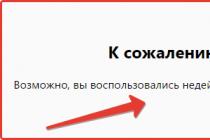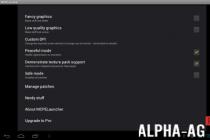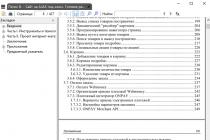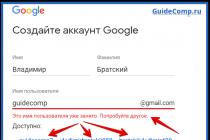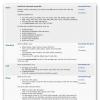I've tested quite a few Android tablets, but every time I put them on the shelf after a few days. The situation changed dramatically when I received the Samsung Galaxy Tab S2 for testing. This is the first Android tablet I want to buy.
Tablet Samsung Galaxy Tab S2 — Reviews
Prior to this review, I've been happy with the second generation iPad mini. The equipment perfectly suited my needs - it was very mobile and had a good quality Retina screen. So I thought until it fell into my hands new tablet Samsung Galaxy Tab S2. I'm not exaggerating, it's like moving from an old car to a new Volvo or Volkswagen.
What Samsung has been doing with the screens of its mobile devices lately deserves the highest praise. The first time I noticed this was Samsung testing Galaxy S6. The Quad HD Super AMOLED panels used just fascinated me. Incredible sharpness, combined with fantastic (and indescribable) colors that looked phenomenal. History repeated itself with the release of Samsung Galaxy Note 5, the screen covers the full range of not only sRGB gamuts, but also the much more demanding AdobeRGB. Independent tests have shown that this is the best screen among all mobile devices at the time of the tests.
After testing the Galaxy S6 with short adventures on the Note 5, I thought it would be great to use the same screen in a large area. Fortunately, I won't have to wait long because I have a Samsung Galaxy Tab S2 in my hands. Already after the first few minutes spent with this device, I knew that this time Samsung did their best.
What's new in Samsung Galaxy Tab S2?
In cases with new smartphones and tablets - data sheet, that's not what interests me the most. I assume that in this price segment, equipment just can't be bad. So is the case with the Galaxy Tab S2, which has an updated Exynos 5433 processor supported by 3 GB random access memory. The tablet runs on Android 5.0.2 Lollipop. Built-in memory (32 or 64 GB), which can be expanded using Micro SD cards. The tablet features a Super AMOLED screen with a resolution of 1536 x 2048 pixels (4:3 aspect ratio) and is available in 8" and 9.7" versions.
When choosing mobile device, many are much more interested in other characteristics, namely quality (ie, look, touch and feel), as well as the screen. In these two categories, the S2 Samsung Galaxy Tab is a premium product. The tablet has a very impressive quality of materials used, beautiful elements and details. You can see here that the developers really approached their work with a soul.
metal case The tablet is almost impossibly thin. The thickness is 5.6 mm, currently the thinnest among tablets. The device is also the lightest in its class, with the 8-inch version I tested weighing just 265 grams. I never thought I'd say this, but compared to my iPad mini equipped Retina display, the new Samsung tablet looks like devices from a much higher shelf.
Aspect ratio is a 'game changer'
The Samsung Galaxy Tab S2 is a completely new approach to the philosophy of Samsung tablets, as well as all Android tablets. What has always puzzled me is why almost all tablets come with a 16:9 or 16:10 screen ratio. But in practice, the 4:3 aspect ratio, which for a long time was offered only by Apple, is much better suited. Some time ago, Google also went this route, introducing the Nexus 9 with much more comfortable proportions. Now Samsung has also joined the 4:3 Club.
Let's agree that the 16:9 aspect ratio is only suitable for a tablet when watching TV shows. Most movies have a wider screen and aspect ratio, so black bars are inevitable anyway. It is clear to everyone that a tablet is not a TV, and even more so there is a cinema. Undoubtedly, there are those who love to watch soap operas passionately on a tablet? I can’t say that I don’t sin with this, but the daily consumption of content from the Internet is more important for me, and it looks completely different here.
A tablet is a phenomenal device for navigating the Internet to read books or magazines, and the 4:3 ratio wins here. I don't know what to say to convince you of the convenience of 4:3, but it's like sheets of A4 paper. After all, we are all used to reading books, documents, magazines and newspapers in the same format.
Orientation is another important aspect of the screen.
The Samsung Galaxy Tab S2 has a resolution of 1536 x 2048 pixels. In a meaningful way, this gives a pixel density of 320 dpi, and in 9.7" it is 264 dpi.
When reading the text, I did not have any comments on sharpness. The edges of the fonts are cutting, regardless of the font size. This is important because it allows you to make content and reading very enjoyable. I also like to read Tablet Tab S2 popular magazines.
Another important aspect for me is images. I really like it when they are crisp and clear. The S2's colorful screen measures about 16.5 x 12.5 cm, which is slightly larger than a standard print. Photos are printed at 300 dpi, and the Samsung Galaxy Tab S2's pixel density is even higher at 320 dpi. Do you have something better? I never complained about the 300dpi print quality, so the device's screen is perfect for viewing photos. Moreover, in some respects better than paper. I remember looking through old photographs through a magnifying glass to see the details. 300 dpi unfortunately didn't stand up to magnifying glass testing, while this problem doesn't exist on a tablet. After all, here any fragment of photos can be enlarged with a finger gesture, without losing detail.
The new Galaxy Tab S2 is slightly smaller than last year's predecessor. It should be remembered that the first Galaxy Tab S in both versions was larger (8.4 and 10.5 inches), and had an aspect ratio of 16:10. This makes resolution changes invisible to the naked eye (359 vs 320 dpi). A further increase in the number of pixels would not be wise. The higher resolution comes at a cost, and the battery in the new Tab S2 is sadly smaller than its predecessor. We are dealing here with an endless struggle between the uncompromising thickness of the device, and the duration of the work. Everyone should evaluate what he cares more about.
Vibrant colors of the Samsung Galaxy Tab S2
The Galaxy Tab S2 uses a Super AMOLED screen. One of the biggest advantages of OLED technology is the deep blacks that are hard to distinguish from the bezel surrounding the device. As a result, the screen contrast is at a very high level. Another plus is the quality of the displayed colors, which is a key aspect for the photographer.
New screen samsung tablet boasts 100% SRGB color gamut display, and up to 94% Adobe RGB. These are results at the levels characteristic of professional solutions, but this is a rarity in the world of mobile devices.
Out of curiosity, I tested how the tablet would perform in an online color vision test. I took a look at it, in a very interesting web application available at igame.com. This is a lot of fun, and the result confirms to some extent the quality of the color reproduction.
Samsung Galaxy Tab S2 - I also use as a mobile imaging companion. I used the device to do this in Adobe Lightroom Mobile. Here, I met a pleasant surprise. My previous tablet only served me to select and rate photos, which could then be synced to my desktop Lightroom. In the case of the Galaxy Tab S2. I could do photo editing, including white balance and color adjustments. Color fidelity was high enough that I could continue editing in full version programs on an external, calibrated computer monitor.
Outcome
Samsung has finally created a device for demanding customers who are looking for not only good performance, but also high quality. The Samsung Galaxy Tab S2 is the first Android tablet I'm considering buying. At the moment, it's just the rather mediocre battery life and price that's holding me back from buying it. But the screen, you just have to see it to appreciate the quality of the display. With a clear conscience, I can recommend it not only for home use, but also for photographers who want to use mobile devices in their work.
The image quality on the screen is really good, I would not hesitate to use the Galaxy Tab S2 in professional photo applications. I don't see any reason not to use the Tab S2 as a mobile briefcase to show off at a client meeting.
To everything, one more aspect should be added. Many people pay attention to the package and judge the device only by its appearance. In this respect, the Samsung Galaxy Tab S2 has absolutely no reason to be ashamed. Even for a complete amateur, the device will look like a premium product that commands respect.
Today we are looking at a new generation of tablets from Samsung - Tab S2, namely 8.0 and 9.7. Last year I did, but then the diagonals were 8.4 and 10.5 ″. This is because the aspect ratio of the display has changed in the new models, now it is 4:3. Here I will briefly talk about my impressions of the devices and what else has changed.
Now devices compete very directly with the iPad mini and iPad Air, since they have completely identical display diagonals and their resolutions. Moreover, the devices also have similar shapes and dimensions. I tried putting both the larger and smaller models into the iPad Air and mini cases respectively and the result was interesting. The Tab S 9.7 turned out to be slightly lower than the Air, and thinner, so it fit into the case but didn't stay in it. But the smaller model didn't just fit into the iPad mini case, it snapped into it perfectly. And this despite a significantly smaller thickness. True, the case simultaneously clamps the lock and volume keys, so the tablet immediately enters recovery mode.

In all other respects, except for the dimensions and general shape, the tablets are outwardly not associated with Apple in any way, they are different and I like them more tactilely. In addition, Samsung is more confident in the hand due to the soft touch coating on the back. Tab S2 is thinner by 2mm, the models are only 5.6mm thick, but at the same time, the devices are not subject to torsion. The metal frame holds the structure well, even with prolonged use this should not be a problem.

Compared to the previous generation, the main orientation of the larger model has changed here. Previously, it was horizontally oriented, small - vertically. Now both have become vertical, as evidenced by the block of control keys below.

The MicroUSB and headset connectors are located at the bottom, along with the speakers. The Tab S2 8.0 also has a microphone, as the tablet can be used as a ceiling lamp. And above the display there is a conversational speaker.




The ergonomics of the devices are all right, I like them both visually and tactilely. Yes, and I did not see any problems in use. But, like last year, there is a caveat. On the back side there are fastenings for standard flip cases. These are holes that will be there whether you buy an accessory or not.



Everything is fixed with a magnetic strip, but there are nuances with it. For example, in the bent back state, this magnet blocks the screen and it cannot be unlocked even with a key. Also, the display is blocked by this magnet and in one of the standard stand positions indicated in the instructions. This is a shortcoming. Well, it is very difficult to insert / get tablets into standard case mounts. They are difficult to snap into place and even more difficult to snap off, it constantly seems that the device will break.







Well, okay, back to the pleasant moments. One of the nicest is the display. Samsung has always been proud of Super Amoled, and these matrices have become very good. Last year we even did a blind comparison with . The last one won. This year the display has become even more beautiful. The resolution is now 2048×1536 pixels, the pixel density of the smaller model is 320 dpi. The structure of the matrix according to the pen tile scheme and this is visible, but if you look closely. Viewing angles, as you would expect, are maximum, there is an anti-reflective coating, different modes image display and one of the best brightness on the market.


Cameras in a tablet, in my opinion, do not have to compete with smartphones, but here they are very good. The main one is 8 MP, the front one is 2.1 MP. Given the aperture ratio of 1.9, they are probably the best among all the tablets on the market. And considering how rarely you'll go to Instagram with a tablet, it's even more good for documents and home photos.

We have Galaxy Note 4 hardware in front of us. Exynos 5433 processor, 3 GB of RAM, Mali-T760 graphics - everything is already known. Moreover, the display resolution is lower than in Note 4, which is why the same tanks come with high fps. In AnTuTu, tablets score about 53,000 points (you can see other tests on the screenshots), but the most important thing is the real speed of the interface and games.
- Dimensions: 134.8 x 198.6 x 5.6 mm (8″) and 237.3 x 169 x 5.6 (9.7″)
- Weight: 272 g and 389
- Operating system: Android 5.0.2 Lollipop.
- Processor: Octa-core, Exynos Octa 5433, 4 x Cortex-A57, 1.9GHz + 4 x Cortex-A53, 1.3GHz
- Graphics: Mali-T760 MP6.
- Display: Super AMOLED, 8.0″ and 9.7″, 2048x1536 pixels
- Memory: 16 GB flash, slot for memory cards up to 128 GB
- RAM: 3 GB.
- Camera: main - 8 MP, - 2.1 MP.
- Wireless technologies: Wi-Fi, Bluetooth 4.1
- Interface connectors: 3.5 mm headphone jack, Micro USB 2.0.
- Battery: Li-Pol battery 4000 and 5870 mAh.
With the interface, everything is fine, with games in two ways. I tested Dead Trigger 2 at maximum settings, it plays smoothly and is generally cool. Things are a little worse with Real Racing 3, ladders are visible, but I think it's a matter of optimization. But with World of Tanks Blitz, everything is really bad. The game produces 60 fps only at low graphics settings, at medium and high we will get an average of 15-20 frames per second. In principle, achieving 10 fps is not a problem.
Despite the similarity of the hardware with the Galaxy Note 4, it's very good that they put a new scanner. That is, you don’t need to fiddle with your finger on it, you just need to touch it and it works well. And in a tablet used for work purposes, data safety is important.


Everything will be stored in the cloud, on 32 GB of built-in space and on a memory card up to 128 GB. But the battery capacity of the 8″ model is 4000 mAh. Like u long-lived smartphone, tablet only. This is perhaps the only drawback of the model that I found. In the game, the device lives a little more than 3 hours, the video will scroll for about 7. Similar autonomy figures for the older model, with larger display there is a capacity of 5870 mAh.
Android OS version 5.0.2, on top of it is a fresh touchscreen with all the features.
I am glad that the standard keyboard here is made for productive work, it is better than in the iPad. There is a cursor, not only backspace, but also cases, as well as combinations of actions with the control key.

For myself, I would settle for a smaller model, it is more versatile. The larger one is even suitable for solving some work issues, especially in a standard case with a BT keyboard.

Given the presence of OTG, here you can also connect a mouse and work fully for some time, like with a laptop. But for myself, I settled on 8 ″ models, they are much more convenient to manage on the road, you can hold them in one hand, and here you can also insert a SIM card if necessary. For example, in another country.

In general, the models are cool, among android tablets, without a twinge of conscience I will say - the best. And you can compare with the iPad forever, these are two different camps and, often, two models of use. iPad is better for games, Tab S2 is better for work. For creating music and video - iPad, for communication and watching videos - Samsung. In general, here everyone is free to decide. There is one thing left - the cost. A 9.7″ model will cost $430, and an 8″ model will cost about $560. We already have it, so the prices are quite normal, even when compared with the same iPads.
Video review of Samsung Galaxy Tab S2 8.0 and 9.7
If you find an error, please highlight a piece of text and click Ctrl+Enter.
At the beginning of 2017, Samsung showed the third updated version line of tablets Galaxy Tab 3. The main competitor for it was and remains the model of the previous generation. And this is not a problem of the company, but of the entire tablet market. Therefore, Samsung Galaxy Tab S2 8.0 SM-T719 LTE 32GB is still an excellent choice in quality Android devices and the main one, in many ways superior to the analogue of the Apple iPad.
The S line is considered the flagship for smartphones and tablets from Samsung. Therefore, even obsolete components after two years do not affect the performance of devices. Central and graphics processors, which were installed in top-end smartphones and tablets two or three years ago, are enough even for complex modern programs.
Appearance
The Tab S2 looks standard by Samsung standards and not bad compared to other tablets on the market. It has narrow bezels on the sides, and wide top and bottom just enough to make it comfortable to hold while watching a movie or playing.
At the bottom of the hardware button "home", touch "back", "list of recent applications." Obviously, they migrated from smartphones, but on such a wide body I would like to have more noticeable indents.
The back of the tablet is made of soft-touch plastic. This is done for ease of grip. At the top is the main camera, which protrudes slightly above the body. When using a cover, this is fully compensated. Closer to the right side are two small holes that are used for branded protection.
Dimensions are almost standard: 134.8 x 198.6 x 5.6 mm. Weighs 272 grams. So thin and light, it is almost not felt when worn.
On the bottom, there are two speakers hidden behind bars, micro-USB, and a microphone. On the right is the power button, volume rocker, nano-SIM and memory card slot.
Sold in the usual black, white colors.
Performance
Some versions of this model used a processor from Samsung - Exynos 5433, but it was in the SM-T719 that the Qualcomm MSM8976 chip - Snapdragon 652 was installed. For a simple user, these names mean little. But both options will confidently run games, work with multiple processes at the same time, play 4K video. Moreover, in the tablet 3 GB RAM.
Antutu shows 47000 points. Although the figure may vary slightly.
As the name suggests, here 32 GB internal memory . 24 is available to the user, but memory cards up to 128 can also be installed. Since the tablet has been updated to 6th android versions , it will be used as a system partition, including for installing applications.
Display
The screen of the Samsung Galaxy Tab S2 tablet at the time of release was the best on the market. Two years later, he will give odds to most tablets, losing only to new models from the same company.

Display with diagonal 7.9 inches made using SuperAMOLED technology. Resolution - 2048x1536 pixels. This gives 326 dpi, which is high for tablets. The aspect ratio is 4:3.
The device has an automatic brightness control. The sensor helps in bright sunlight. A system utility has been installed to change the screen mode. It can be used to increase saturation when watching movies, games, or vice versa to decrease if AMOLED colors are repulsive.
Battery
Surprising battery capacity - only 4000 mAh. But it is worth remembering about the energy-efficient chipset and AMOLED, which greatly saves battery by turning off unnecessary pixels.
If a cellular communication do not use, and turn on the Internet only via Wi-Fi, then with an average load it will be enough for a day. If you insert a SIM card, then the operating time will noticeably decrease, and the screen will last 2-3 hours.
There is an extreme power saving mode in which the background turns black. This means that most of the screen turns off. Data transfer is limited. When fully charged in this mode, the tablet will work for 4-5 days.
Wireless interfaces
This tablet model supports latest versions WiFi, LTE. Bluetooth 4.1. Navigation using GPS, GLONASS.

The lack of infrared ports, NFC and, accordingly, Samsung Pay is frustrating. The tablet does not need them much, but given its positioning as a flagship, this fact is frustrating. Still, Samsung made a thin device that you can always carry with you, but did not provide for modern features, such as contactless payments.
Camera
In this direction Samsung act wisely. In their smartphones, one of best cameras on the market, and in tablets - such that can be useful on a device 20 cm long. Nevertheless, they are still the best among tablets.
In Tab S2 8 megapixel main, 2.1-megapixel front. There are no flashes.
There are enough opportunities to shoot if necessary, to photograph documents and selfies, especially in good weather conditions.
The program has seven modes at once:
- auto;
- panorama;
- virtual shooting;
- rich tones (HDR);
- post-effect;
- double chamber.
Three deserve special attention.
In mode virtual shooting the user can, moving around the object, create its full-fledged 3D model.

Although HDR makes pictures brighter and more saturated, the process takes place programmatically, so you should not expect particularly high quality.
The post-effect allows you to change some photo settings after shooting. Dual camera creates 2 photos from the main and front cameras on one image at once.
Operating system
Initially, the Galaxy Tab S2 ran on Android 5.0, but over time it was updated to version 6. Above is the familiar TouchWiz. Unfortunately, it's still pretty much changed from what it was before. standard Android. Not everyone will like and suit such an overly bright design, but in terms of functionality, there are no problems. All built-in programs voice control- at a very high level.
As always, Samsung offers its users many different gifts: OneDrive internal storage, Bookmate subscription, Amediateka.
A fingerprint sensor is installed in the hardware button for unlocking with a fingerprint.
Advantages and disadvantages
pros
- display;
- new OS version;
- Samsung partner offers;
- dimensions.
Minuses
- battery.
Conclusion
The review of the Samsung Galaxy Tab S2 8.0 shows that this is an excellent continuation of the line, which replaced the previous generation and can become an alternative to the next one.
He has one of best screens, decent camera performance, high-quality body. The battery is one of the main drawbacks. It may be enough for movies, but in games and programs, the tablet will run out quickly.
The most frustrating thing is the price. Although Samsung hasn't added all the features of a truly flagship device to the tablet, as it does with smartphones, the cost has set the top. Paying for an imperfect tablet over $500 worth it only if you like a particular manufacturer. And given the noticeably fallen attention of users to this category of devices, it is surprising that even with such a high price, it sells very well.
Information about the make, model, and alternative names of a particular device, if any.
Design
Information about the dimensions and weight of the device, presented in different units of measurement. Used materials, suggested colors, certificates.
| Width Width information refers to the horizontal side of the device in its standard orientation during use. | 198.6 mm (millimeters) 19.86 cm (centimeters) 0.65 ft 7.82in |
| Height Height information refers to the vertical side of the device in its standard orientation during use. | 134.8 mm (millimeters) 13.48 cm (centimeters) 0.44ft 5.31in |
| Thickness Information about the thickness of the device in different units measurements. | 5.6 mm (millimeters) 0.56 cm (centimeters) 0.02 ft 0.22in |
| The weight Information about the weight of the device in different units of measurement. | 272 g (grams) 0.6 lbs 9.59oz |
| Volume Approximate volume of the device, calculated from dimensions provided by the manufacturer. Refers to devices with the shape of a rectangular parallelepiped. | 149.92 cm³ (cubic centimeters) 9.1 in³ (cubic inches) |
| Colors Information about the colors in which this device is offered for sale. | Black White |
| Housing materials The materials used to make the body of the device. | Metal Plastic |
SIM card
The SIM card is used in mobile devices to store data that certifies the authenticity of mobile service subscribers.
Mobile networks
A mobile network is a radio system that allows multiple mobile devices to communicate with each other.
| GSM GSM (Global System for Mobile Communications) is designed to replace the analogue mobile network (1G). For this reason, GSM is often referred to as a 2G mobile network. It is enhanced by the addition of GPRS (General Packet Radio Services) and later EDGE (Enhanced Data rates for GSM Evolution) technologies. | GSM 850 MHz GSM 900 MHz GSM 1800 MHz GSM 1900 MHz |
| UMTS UMTS is short for Universal Mobile Telecommunications System. It is based on the GSM standard and belongs to 3G mobile networks. Developed by 3GPP and its biggest advantage is to provide more speed and spectral efficiency with W-CDMA technology. | UMTS 850 MHz UMTS 900 MHz UMTS 1900 MHz UMTS 2100 MHz |
| LTE LTE (Long Term Evolution) is defined as fourth generation (4G) technology. It is developed by 3GPP based on GSM/EDGE and UMTS/HSPA to increase the capacity and speed of wireless mobile networks. The subsequent development of technologies is called LTE Advanced. | LTE 800 MHz LTE 850 MHz LTE 900 MHz LTE 1800 MHz LTE 1900 MHz LTE 2100 MHz LTE 2600 MHz LTE 700 MHz |
Mobile technologies and data rates
Communication between devices in mobile networks is carried out through technologies that provide different data rates.
Operating system
The operating system is the system software that manages and coordinates the operation of the hardware components in the device.
SoC (System on a Chip)
System on a chip (SoC) includes all the most important hardware components of a mobile device in one chip.
| SoC (System on a Chip) System on a chip (SoC) integrates various hardware components such as processor, graphics processor, memory, peripherals, interfaces, etc., as well as the software necessary for their operation. | Samsung Exynos 5 Octa 5433 |
| Technological process Information about the technological process by which the chip is made. The value in nanometers measures half the distance between the elements in the processor. | 20 nm (nanometers) |
| Processor (CPU) The main function of the processor (CPU) of a mobile device is the interpretation and execution of instructions contained in software applications. | 4x 1.9 GHz ARM Cortex-A57, 4x 1.3 GHz ARM Cortex-A53 |
| Processor bit depth The bit depth (bits) of a processor is determined by the size (in bits) of registers, address buses, and data buses. 64-bit processors have higher performance than 32-bit processors, which, in turn, are more productive than 16-bit processors. | 64 bit |
| Instruction Set Architecture Instructions are commands by which the software sets/controls the operation of the processor. Information about the instruction set (ISA) that the processor can execute. | ARMv8-A |
| First level cache (L1) Cache memory is used by the processor to reduce access time to more frequently accessed data and instructions. L1 (level 1) cache is small and much faster than both system memory and other cache levels. If the processor does not find the requested data in L1, it continues to look for them in the L2 cache. With some processors, this search is performed simultaneously in L1 and L2. | 32 kB + 32 kB (kilobytes) |
| Second level cache (L2) L2 (level 2) cache is slower than L1, but in return it has a larger capacity, allowing more data to be cached. It, like L1, is much faster than system memory (RAM). If the processor does not find the requested data in L2, it continues to look for it in the L3 cache (if available) or RAM. | 2048 KB (kilobytes) 2 MB (megabytes) |
| Number of processor cores The processor core performs program instructions. There are processors with one, two or more cores. Having more cores increases performance by allowing many instructions to be executed in parallel. | 8 |
| Processor clock speed The clock speed of a processor describes its speed in terms of cycles per second. It is measured in megahertz (MHz) or gigahertz (GHz). | 1900 MHz (megahertz) |
| Graphics Processing Unit (GPU) Graphics Processing Unit (GPU) handles calculations for various 2D/3D graphic applications. In mobile devices, it is used most often by games, consumer interface, video applications, etc. | ARM Mali-T760 MP6 |
| Number of cores GPU Like the CPU, the GPU is made up of several working parts called cores. They handle the graphical calculations of different applications. | 6 |
| GPU clock speed The speed of work is clock frequency GPU, which is measured in megahertz (MHz) or gigahertz (GHz). | 700 MHz (megahertz) |
| The amount of random access memory (RAM) Random access memory (RAM) is used by the operating system and all installed applications. Data stored in RAM is lost when the device is turned off or restarted. | 3 GB (gigabytes) |
| Type of random access memory (RAM) Information about the type of random access memory (RAM) used by the device. | LPDDR3 |
| Number of RAM channels Information about the number of RAM channels that are integrated into the SoC. More channels means higher data rates. | dual channel |
| RAM frequency The frequency of RAM determines its speed, more specifically, the speed of reading / writing data. | 825 MHz (megahertz) |
Built-in memory
Each mobile device has a built-in (non-removable) memory with a fixed amount.
Memory cards
Memory cards are used in mobile devices to increase the storage capacity for storing data.
Screen
The screen of a mobile device is characterized by its technology, resolution, pixel density, diagonal length, color depth, etc.
| Type/technology One of the main characteristics of the screen is the technology by which it is made and on which the image quality of information directly depends. | Super AMOLED |
| Diagonal For mobile devices, the screen size is expressed in terms of its diagonal length, measured in inches. | 8 in 203.2 mm (millimeters) 20.32 cm (centimeters) |
| Width Approximate Screen Width | 6.4in 162.56 mm (millimeters) 16.26 cm (centimeters) |
| Height Approximate Screen Height | 4.8in 121.92 mm (millimeters) 12.19 cm (centimeters) |
| Aspect Ratio The ratio of the dimensions of the long side of the screen to its short side | 1.333:1 4:3 |
| Permission Screen resolution indicates the number of pixels vertically and horizontally on the screen. Higher resolution means sharper image detail. | 2048 x 1536 pixels |
| Pixel Density Information about the number of pixels per centimeter or inch of the screen. Higher density allows information to be shown on the screen in clearer detail. | 320 ppi (pixels per inch) 125ppm (pixels per centimeter) |
| Color depth Screen color depth reflects the total number of bits used for the color components in a single pixel. Information about the maximum number of colors the screen can display. | 24 bit 16777216 flowers |
| Screen area Approximate percentage of screen space on the front of the device. | 74.27% (percentage) |
| Other characteristics Information about other functions and features of the screen. | capacitive Multitouch |
Sensors
Different sensors perform different quantitative measurements and convert physical indicators into signals that are recognized by the mobile device.
rear camera
The main camera of a mobile device is usually located on its rear panel and can be combined with one or more additional cameras.
| Sensor model | Samsung S5K4H5 |
| Sensor type Information about the type of camera sensor. Some of the most widely used sensor types in mobile device cameras are CMOS, BSI, ISOCELL, etc. | CMOS BSI (backside illumination) |
| Sensor size | 3.6 x 2.7 mm (millimeters) 0.18in |
| Pixel size | 1.103 µm (micrometers) 0.001103 mm (millimeters) |
| crop factor | 9.61 |
| Svetlosila | f/1.9 |
| Focal length | 3.23 mm (millimeters) 31.02 mm (millimeters) *(35 mm / full frame) |
| Image Resolution | 3264 x 2448 pixels 7.99 MP (megapixels) |
| Video resolution | 2560 x 1440 pixels 3.69 MP (megapixels) |
| Video recording speed (frame rate) Information about the maximum recording rate (frames per second, fps) supported by the camera at maximum resolution. Some of the most basic video recording speeds are 24 fps, 25 fps, 30 fps, 60 fps. | 30 fps (frames per second) |
| Characteristics Information about additional software and hardware features of the rear (rear) camera. | autofocus digital zoom Self-timer Scene Selection Mode |
Front-camera
Smartphones have one or more front cameras of various designs - a pop-up camera, a PTZ camera, a cutout or hole in the display, a camera under the display.
| Sensor model Information about the manufacturer and model of the sensor used by the camera. | Samsung S5K6B2 |
| Sensor size Information about the size of the photosensor used in the device. Typically, cameras with a larger sensor and lower pixel density offer better image quality despite lower resolution. | 2.4 x 1.8 mm (millimeters) 0.12in |
| Pixel size Pixels are usually measured in microns. Larger pixels are capable of capturing more light and therefore provide better low-light shooting and a wider dynamic range than smaller pixels. On the other hand, smaller pixels allow higher resolution while maintaining the same sensor size. | 1.25 µm (micrometers) 0.001250 mm (millimeters) |
| crop factor The crop factor is the ratio between the size of a full-frame sensor (36 x 24mm, equivalent to a frame of standard 35mm film) and the size of the device's photosensor. The number shown is the diagonal ratio of the full-frame sensor (43.3 mm) and the photosensor specific device. | 14.42 |
| Svetlosila Luminosity (also known as f-stop, aperture, or f-number) is a measure of the size of a lens aperture that determines the amount of light that enters the sensor. The lower the f-number, the larger the aperture and the more light reaches the sensor. Usually, the number f is indicated, which corresponds to the maximum possible aperture of the aperture. | f/2.2 |
| Focal length Focal length indicates the distance in millimeters from the sensor to the optical center of the lens. The equivalent focal length (35mm) is the focal length of a mobile device camera that is equal to the focal length of a 35mm full-frame sensor that would achieve the same angle of view. It is calculated by multiplying the actual focal length of the mobile device's camera by the crop factor of its sensor. The crop factor can be defined as the ratio between the 35mm diagonals of a full-frame sensor and a mobile device sensor. | 1.87 mm (millimeters) 26.97 mm (millimeters) *(35 mm / full frame) |
| Image Resolution One of the main characteristics of cameras is resolution. It represents the number of horizontal and vertical pixels in an image. For convenience, smartphone manufacturers often list resolution in megapixels, giving an approximate number of pixels in millions. | 1920 x 1080 pixels 2.07 MP (megapixels) |
| Video resolution Information about the maximum video resolution that the camera can record. | 1920 x 1080 pixels 2.07 MP (megapixels) |
Audio
Information about the type of speakers and audio technologies supported by the device.
Radio
The radio of the mobile device is a built-in FM receiver.
Location determination
Information about navigation and location technologies supported by the device.
WiFi
Wi-Fi is a technology that provides wireless communication to transfer data over short distances between different devices.
Bluetooth
Bluetooth is a standard for secure wireless data transfer between different types of devices over short distances.
USB
USB (Universal Serial Bus) is an industry standard that allows different electronic devices to communicate.
Headphone jack
This is an audio connector, which is also called an audio jack. The most widely used standard in mobile devices is the 3.5mm headphone jack.
Connecting devices
Information about other important connection technologies supported by the device.
Browser
A web browser is a software application for accessing and viewing information on the Internet.
Video file formats/codecs
Mobile devices support various video file formats and codecs, which store and encode/decode digital video data, respectively.
Battery
Mobile device batteries differ from each other in their capacity and technology. They provide the electrical charge they need to function.
Specific Absorption Rate (SAR)
SAR levels refer to the amount of electromagnetic radiation absorbed by the human body while using a mobile device.
| SAR level for head (EU) The SAR level indicates maximum amount electromagnetic radiation that the human body is exposed to when holding a mobile device next to the ear in a conversation position. In Europe, the maximum allowable SAR value for mobile devices is limited to 2 W/kg per 10 grams of human tissue. This standard established by CENELEC in accordance with IEC standards following ICNIRP guidelines of 1998. | 0.345 W/kg (watt per kilogram) |
| Body SAR (EU) The SAR level indicates the maximum amount of electromagnetic radiation that the human body is exposed to when holding a mobile device at hip level. The maximum allowed SAR value for mobile devices in Europe is 2 W/kg per 10 grams of human tissue. This standard has been established by CENELEC following the 1998 ICNIRP guidelines and IEC standards. | 0.472 W/kg (watt per kilogram) |
| Head SAR (US) The SAR level indicates the maximum amount of electromagnetic radiation that the human body is exposed to when holding a mobile device near the ear. The maximum value used in the US is 1.6 W/kg per gram of human tissue. Mobile devices in the US are controlled by the CTIA and the FCC conducts tests and sets their SAR values. | 0.957 W/kg (watt per kilogram) |
| Body SAR (US) The SAR level indicates the maximum amount of electromagnetic radiation that the human body is exposed to when holding a mobile device at hip level. The highest acceptable SAR value in the US is 1.6 W/kg per gram of human tissue. This value is set by the FCC, and the CTIA controls whether mobile devices comply with this standard. | 1.593 W/kg (watt per kilogram) |
Samsung's new 8-inch tablet looks like two drops of water similar to its older brother Galaxy Tab S2 9.7. As a "stuffing", as far as possible, the same components are also used. Let's check if moving to more compact sizes causes a decrease in device performance.Together with the Galaxy Tab S2 9.7, a competitor to the iPad-Air-2, Samsung has released a more compact one, which can be considered as an alternative iPad Mini 4. The design of the novelty is reminiscent of Galaxy A series smartphones. The main difference from its predecessor Galaxy Tab S 8.4 is a 4:3 display instead of 16:10. The amount of RAM remains the same and is 3 GB. Like the Galaxy Tab S 8.4, the Galaxy Tab S2 8.0 LTE uses Samsung's 1.9GHz Exynos SoC but uses a more modern chip. Samsung Galaxy Tab S2 8.0 with module mobile communications LTE is about 5,000 rubles more expensive than the Wi-Fi-only version of the tablet. Direct Galaxy competitors The Tab S2 8.0 are the super-new iPad Mini 4 and its Android counterparts the Sony Xperia Z3 Tablet Compact and the smaller Google Nexus 9.
Technical Galaxy specifications Tab S2 8.0: |
|
| Screen | 8'' 4:3 resolution, 2048 x 1536 pixels, glossy surface, glass, Super AMOLED, Capacitive Multi-Touch, up to 10 touches, G-sensor; |
| CPU | Exynos 7 Octa (5433) 8 cores (4+4), up to 1.9 GHz + 1.3 GHz; |
| graphics accelerator | Mali-T760; |
| Operating system | Android 5.0.2 (Lollipop); |
| RAM | 3 GB; |
| Built-in memory | 32 GB; |
| Memory card support | microSDXC, microSDHC, microSD up to 128 GB; |
| Connection | GSM, HSPA+, LTE cat.6, VoLTE, standards 700/ 800/ 850/ 900/ 1800/ 1900/ 2100/ 2600; |
| SIM card | Nano-SIM (12 x 9 mm); |
| Wireless interfaces | Wi-Fi a/b/g/n/ac IEEE 802.11ac, IEEE 802.11n, IEEE 802.11g, IEEE 802.11b, IEEE 802.11a, Bluetooth 4.1; |
| Sound | built-in speakers x2 on the bottom; |
| Navigation | GPS (satellite), A-GPS ( base station GSM), GLONASS; |
| cameras | main - 8 million pixels, autofocus, aperture f1 / 9, video recording QHD (2560 x 1440) @ 30fps; front - 2.1 million pixels, fixed focus; |
| Sensors | accelerometer, compass, Hall sensor, gyroscope, RGB sensor, fingerprint scanner; |
| Connectors | micro USB 2.0, headphone jack, Nano-SIM slot, USB OTG support; |
| Battery | 4000 mAh (Li-Pol battery; charging time - 210 minutes); |
| Dimensions | 19.86 x 0.56 x 13.48 cm; |
| The weight | 0.272 kg; |
| Color options | White black; |
Frame
Size aside, the Galaxy Tab S2 8.0 looks exactly like the 9.7-inch model. The only difference is the speaker slot above the Samsung logo on the 8-inch model. The Galaxy Tab S2 8.0 is thinner and noticeably shorter than its predecessor, the Galaxy Tab S 8.4, due to the transition to a 4:3 screen format, it “recovered” in width by almost a centimeter. The camera protrudes a little inaccurately by about 1.8 mm above the back of the tablet. In terms of lightness, with a weight of 272 grams, only SONY Xperia Z3 Tablet Compact weighing 270 grams can be compared.The previous flagship tablet Galaxy Tab S 8.4 looked like the corresponding flagship tablet. Galaxy smartphone S5. Design new Galaxy The Tab S2 8.0 is inspired by the Galaxy A smartphones. For the first time, the tablet features an eye-catching, shiny yet rough-feel metal frame. Back cover made of rough plastic; The tablet does not try to slip out of the hands. Unfortunately, fingerprints case Galaxy The Tab S2s become visible fairly quickly and are hard to wipe off. On the back of the device, you can see the latches for separately purchased cases. The metal frame makes the Galaxy Tab S2 feel very solid. The gaps are small, when you try to twist the tablet, only a slight crackle is heard.

Components
It uses the same components as the Galaxy Tab S2 9.7. The tablet has an Exynos 5433 Octa SoC 1.9 GHz processor, 3 GB of RAM and a 32 GB flash drive, of which 25 GB is available to the user. It supports the use of microSD memory cards up to 128 GB and the transfer of programs and applications to the memory card.
The power supply and external devices are connected to the tablet via the Micro USB 2.0 connector. It's a pity that not through the latest USB 3.0 Type C. The good news is USB-OTG support for connecting a peripheral device (flash drive, keyboard, mouse, etc.) and MHL for transferring photos and videos to a large display. Supports Bluetooth 4.1, WiFi Direct for wireless image transmission and ANT+ for wireless transmission of information from sensors. Infrared, like the Galaxy Tab S 8.4, the Tab S2 8.0 does not. NFC technology not supported.
Pleased with the presence in the tablet of a vibration motor for tactile feedback. The tablet does not have LED indicators familiar to users of Android smartphones.
Right side: Nano-SIM card slot, microSD card slot, volume control, power key Left side: no connectors.

Bottom: speaker, 3.5 mm headphone jack, microphone, Micro-USB connector, another speaker. Top: microphone

Software
As operating system using Android 5.0.2 with Samsung TouchWiz shell. To date, TouchWiz leaves a favorable impression and offers many additional features and customization tools. Whether an update to Android 5.1 or 6.0 will be released for the tablet is, unfortunately, not yet known. As usual with Samsung tablets, the Tab S2 8.0 comes preloaded with a plethora of third-party apps. Most of these apps are easy to uninstall. Microsoft Office applications (Word, Excel, PowerPoint, OneNnote, Skype, OneDrive) are not completely removed, you can only deactivate their individual components.





A bunch of Samsung programs offer helper functions. So, smart app Switch makes it easy to switch to a new tablet by transferring settings, contacts, and data from another mobile device. Check out the SideSync app to control your tablet from a Windows PC or mobile device. Unfortunately, an attempt to control from another Samsung tablet was unsuccessful. At the same time, the connection between the Windows laptop and Tab S2 8.0 after installing the appropriate software on the laptop worked fine. Long press on the left touch button split screen mode is activated.
Communications and GPS
Built-in WLAN a/b/g/n/ac provides very high speed data transmission. When contacting ASUS router RT-AC56U, this speed reached 780 Mbps with a theoretical limit of 866 Mbps in the 5 GHz band. As the distance between the tablet and the router increases, the data transfer speed decreases slightly. Module range wireless communication The Tab S2 8.0 and reception quality in both the 2.4GHz and 5GHz bands are on par with other comparable mobile devices.
In the absence of Wi-Fi, it is possible to use an LTE modem with a data transfer rate of up to 300 Mbps (LTE Cat. 6). If necessary, for example, when downloading a large amount of data, you can activate the "accelerator" for the parallel use of Wi-Fi and mobile networks.
Thanks to the presence of a conversational speaker, Tab S2 8.0 can be used as a giant smartphone. Galaxy Tab S2 9.7 does not have this feature. Tab S2 8.0 voice quality at phone calls is at a high level, like expensive smartphones. When using a headset, as long as the background noise level is not too high, speech is also intelligible.

Tablet supports satellite systems GPS navigation and Glonass. Outdoors, the current position is determined fairly quickly; reception strength is slightly lower than Galaxy Tab S2 9.7. Indoors, GPS satellite signals are not detected even after a long wait.
Using the Garmin Edge 500 Tab S2 8.0 cycling computer as a control device, it showed a slight overall deviation of 2% and the tendency to “cut off” the path characteristic of many tablets. The Galaxy Tab S2 9.7 is a bit more accurate in terms of positioning, and the Apple iPad Mini 4 is the absolute champion, surpassing even navigators.
cameras
The Galaxy Tab S2 8.0 uses the same cameras as the older one Galaxy models Tab S2 9.7. On the front side of the tablet is a selfie camera with a rather pathetic resolution of 2.1 megapixels (1920x1080, 16:9 format, aperture 1 / 2.2). Selfies, unfortunately, are fuzzy and pale.selfie camera with a rather pathetic 2.1 megapixel resolution

Photos from the 8-megapixel rear camera (3264x2448, 4:3 aspect ratio) are significantly better, although they are not comparable in quality to pictures taken by cameras of modern high-end smartphones. On the other hand, few tablets can take better photos than the .
It's a shame that using a faster lens (1/1.9 on the Galaxy Tab S2 instead of 1/2.4 on the Galaxy Tab S) didn't improve the quality of low-light shots. As before, such images are characterized by high digital noise (the appearance of a noticeable number of dots of random color and brightness) and loss of detail. Also, unlike its predecessor, the Galaxy Tab S2 does not have an LED flash.
On closer examination, you can notice a loss of clarity in the corners of the pictures. Due to the location of the camera near the edge of the tablet, when photographing in landscape orientation, make sure that your fingers do not get into the frame. From automatic mode, you can switch to professional mode and manually set the white balance, ISO sensitivity value, exposure compensation, etc. In addition, there are applications for obtaining HDR (with extended range of brightness) - and panoramic shots.
Galaxy Tab S2 8.0 provides high quality video recording. Supports recording at 2560x1440 resolution of the popular 16:9 format at up to 30 frames per second. It's an improvement over its predecessor, the Galaxy Tab S, which can capture video at resolutions up to Full-HD.
You cannot take photos at the same time as recording video in maximum resolution. Also, in the maximum resolution video recording mode, electronic image stabilization does not work. Recordings in both Full-HD and QHD quality are crisp and clear. Video stills have better detail and more vibrant colors than photos taken with the front camera. Front-camera, however, captures video at 1080p at 30fps and can be used on occasion for video calls.
8 megapixel rear camera





Accessories
Like the Galaxy Tab S2 9.7, the package is limited to the bare essentials. The tablet comes with a quick start guide, Charger, USB cable 5V 2A and a small metal tool for ejecting Nano-SIM or microSD cards. Additionally, you can.
Input Devices
Sensory Galaxy screen The Tab S2 handles touch with precision. There is no need to put any pressure on the screen; fingers slide across protective glass with very little friction.

An advanced fingerprint scanner is built into the Home key. A similar scanner is used in the top-end smartphones Samsung Galaxy S6 and S6 Edge. You no longer need to swipe your finger across the scanner over and over again, just one touch is enough. It is possible to use the scanner when shopping in a store Samsung apps or for access in web forms. To built-in system on-screen keyboard hard to complain. Supports already familiar functions of suggesting words and continuous (without taking your finger off the screen) input. If desired, the keyboard can be moved from the edge of the screen to any other location on the display. You can also split the keyboard into 2 parts to make it easier to type with your thumbs.
The tablet responds quickly to user actions, annoying slowdowns are not observed even when switching between applications. To change the screen orientation (from vertical to horizontal or vice versa), the tablet with some delay responds with a very smooth rotation of the display contents. The lag probably serves to prevent an accidental turn.
Screen
8" Super-AMOLED Galaxy display The Tab S2 8.0 4:3 aspect ratio delivers the same 2048 x 1536 resolution as the 9.7-inch model. The pixel density of the Galaxy Tab S2 8.0 has a fairly high 320 ppi, which, however, does not exceed the density of 359 ppi of the Galaxy Tab S 8.4 predecessor.The average screen brightness of the tablet is 348 cd/m2, which is well above the 261 cd/m2 of its predecessor, but lower than the brightness of LCD screens, which, for example, the iPad Mini 4 or Sony Xperia Z3 Tablet Compact exceeds 400 cd/m2. To ensure readability of information from the screen, the brightness during auto-adjustment, depending on the readings of the light sensor, may exceed the values manually set by the user.
Unlike LCD screens, a Super-AMOLED display does not require a backlight, so the black dot brightness of a Super-AMOLED display is 0 cd/m2, while the contrast of a Super-AMOLED display tends to infinity. Competing tablets with LCD screens in terms of contrast cannot fundamentally compete with the Galaxy Tab S2. Thus, the Lenovo Yoga 2 8 LED screen has the maximum contrast ratio of 1556:1 among comparable tablets. It should also be noted that, according to subjective perception, the colors on the screen are displayed most vividly.
Like the Galaxy Tab S2 9.7, the user of the 8-inch model has access to the AMOLED Movie, AMOLED Photo, Basic, Reading color modes, as well as the Adaptive Display mode, in which the color spectrum, saturation and clarity is adjusted automatically depending on the nature of the information displayed on the screen.

Performance and gaming
Like the 9.7-inch modification, it uses Samsung's own Exynos 5433 Octa ARM processor, which is a single-chip SoC system. Unlike the Exynos 5420 used in the first generation Galaxy Tab, the Exynos 5433 supports 64-bit applications. Like all Exynos 7 Octa 8-core processors, the 5433 works according to the big.LITTLE principle: 4 high-performance Cortex-A57 cores with a frequency of up to 1.9 GHz are activated under high load, and 4 economical Cortex-A53 cores with a frequency of up to 1.3 GHz allow reduce power consumption when high processing power is not needed. If necessary, all 8 cores are included in the work. Built into the processor graphics core Mali-T760 MP6.The Galaxy Tab S2 8.0 delivers first-class results and outperforms the SONY Xperia Z3 Tablet Compact. Subjectively, the performance of the Galaxy Tab S2 8.0 is more than enough for fast web browsing, launching web applications and interacting with web services.
in Idle mode does not exceed 30°C. Of the competitors, only the Lenovo Yoga 2 8 stays noticeably cooler in standby mode. Under load, the Galaxy Tab S2 8.0 does not rise above 43°C, which is significantly higher than its predecessor, the Galaxy Tab S 8.4, but at the same level as current competitors.
Like the Galaxy Tab S2 9.7, the drop in performance of the Galaxy Tab S2 8.0 observed in GFXBench at long work tablet under load is up to 40%, and the frequency of the graphics card is from 600 MHz to 350 MHz. Due to throttling, slowdowns are possible during a long game on the tablet.
power usage
When it comes to power consumption, the Galaxy Tab S2 8.0 doesn't do much. In Idle mode, only the larger Google Nexus 9 is more “gluttonous” than the Galaxy Tab S2 8.0. Under load, only the Lenovo Yoga 2 8 Windows tablet consumes more than the Galaxy Tab S2 8.0. The 10-watt power supply (5V, 2A) supplied is barely enough to power the Galaxy Tab S2 8.0 under load; There is almost no reserve left to charge the battery. When the display is off, the battery charging time is about 2.5 hours. Galaxy Tab S2 8.0 does not charge from a regular USB port in Standby mode; it is possible to charge from the USB port only when the tablet is turned off.Battery life
It would seem that the 23% lower battery capacity and higher power consumption compared to its predecessor do not bode well for this tablet's acceptable battery life. However, the Galaxy Tab S2 8.0, both in Idle mode and under load, “holds on” longer than the Galaxy Tab S 8.4. More than 7 hours in internet tablet mode is sufficient for most users. In terms of H.264 1080p video playback (13 hours), the Galaxy Tab S2 8.0 is second only to the Sony Xperia Z3 Tablet Compact.Samsung is probably using some trick to extend the battery life of the tablet. For example, display brightness is reduced by 5% when switching to battery power, regardless of current settings and without going into power save mode.
Conclusion
pros |
Minuses |
||
+ |
Very thin and light | - |
Significant throttling under stress |
+ |
Workmanship | - |
Micro-USB-2.0 only |
+ |
microSD card slot | - |
No NFC |
+ |
AC-WLAN & Bluetooth 4.1 | - |
Missing infrared port, which was the predecessor |
+ |
The fingerprint scanner | - |
GPS receiver is slightly weaker than Galaxy Tab S2 9.7 |
+ |
High precision touch screen | - |
|
+ |
QHD video recording | - |
|
+ |
Speaker for use as a phone | - |
|
+ |
Excellent display with exceptional contrast and color reproduction |

